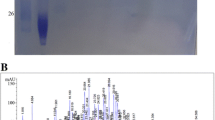Abstract
Primary rat gastric cell cultures were investigated as an in vitro model for evaluating antiulcer agents. Following exposure to concentrations of up to 5 mg/mL of an antiulcer agent sucralfate, an aluminum hydroxide complex of sucrose octasulfate, cultured cells were treated with either pH 3.5 medium or 3.5 mM indomethacin. Cytoprotection was evaluated by colony forming efficiency, neutral red uptake, and 3-(4,5-dimethyl-2-thiazoyl)-2,5-diphenyl-2H-tetrazolium bromide (MTT) hydrolysis. By each measure, and depending on damaging agent, 2 and 5 mg/mL sucralfate provided partial (50% of untreated control) to near-complete (90% of untreated control) cytoprotection, respectively. Aluminum hydroxide also provided partial (55% of untreated control) to near-complete (more than 90% of untreated control) cytoprotection at 2 and 5 mg/mL, respectively, for the pH 3.5 medium-induced damage. Over a concentration range of 0.05 to 5 mg/mL, the potassium salt of sucrose octasulfate, KSOS, stimulated cell growth up to 40–60% over untreated controls but had little or no cytoprotective action in the presence of either 3.5 mM indomethacin or pH 3.5 medium. Overall results suggested that sucralfate may have at least two roles in influencing gastric epithelial cell function, cytoprotection and stimulation of cell growth in vitro. These observations serve as a basis for further study of in vitro models in evaluating the cytoprotective activity of antiulcer agents and their respective mechanisms of action.
Similar content being viewed by others
REFERENCES
M. Romano, M. Razandi, and K. J. Ivey. Effect of sucralfate and its components on taurocholate-induced damage to rat gastric mucosal cells in tissue culture. Digest. Dis. Sci. 35:467–476 (1990).
S. Ota, M. Razandi, S. Sekhon, A. Terana, H. Hiraishi, and K. J. Ivey. Cytoprotective effect of acetaminophen against taurocholate-induced damage to rat gastric monolayer cultures. Digest. Dis. Sci. 33:938–944 (1988).
R. A. Levine, J. Nandi, and R. L. King. Nonsalicylate nonsteroidal antiinflammatory drugs augment prestimulated acid secretion in rabbit parietal cells. Gastroenterology 101:756–765 (1991).
J. M. Scheiman, E. R. Kraus, L. A. Bonnville, P. A. Weinhold, and C. R. Boland. Synthesis and prostaglandin E2-induced secretion of surfactant phospholipid by isolated gastric mucous cells. Gastroenterology 100:1232–1240 (1991).
M. M. Cohen, R. Bowdler, P. Gervais, G. P. Morris, and H. Wang. Sucralfate of human gastric mucosa against acute ethanol injury. Gastroenterology 96:292–298 (1989).
F. Martin, A. Farley, M. Gagnon, and D. Bensemana. Comparison of the healing capacities of sucralfate and cimetidine in the short-term treatment of duodenal ulcer: A double-blind randomized trial. Gastroenterology 82:401–405 (1982).
S. K. Lam, W. Y. Lau, and C. L. Lai. Efficacy of sucralfate in corpus, prepyloric and duodenal ulcer-associated gastric ulcers. Am. J. Med. 79 (Suppl. 2C):24–31 (1985).
S. Okabe, K. Takeuchi, H. Kunimi, M. Kanno, and M. Kawashima. Effects of an antiulcer drug, sucralfate (a basic aluminum salt of sulfated disaccharide), on experimental gastric lesions and gastric secretion in rats. Digest. Dis. Sci. 28:1034–1042 (1983).
A. Tarnawaki, D. Hollander, H. Gergely, and J. Stachura. Comparison of antacid sucralfate, cimetidine and ranitidine in protection of gastric mucosa against ethanol injury. Am. J. Med. 79:19–23 (1985).
D. Hollander, A. Tarnawski, W. Krause, and H. Gergely. Protective effect of sucralfate against alcohol-induced gastric mucosa injury in the rat. Macroscopic, histologic, ultrastructural and functional time sequence analysis. Gastroenterology 88:366–374 (1985).
L. D. Bighley and D. H. Giesing. Mechanism of action studies of sucralfate. In W. F. Caspary (ed.), Duodenal Ulcer, Gastric Ulcer: Sucralfate. A New Therapeutic Concept, Urban & Schwarzenberg, Baltimore, 1981, pp. 3–12.
R. Nagashima. Mechanism of action of sucralfate. J. Clin. Gastroenterol. 3 (Suppl. 2):117–127 (1981).
D. H. Giesing, L. D. Bighley, and R. L. Fles. Effect of food and antacid on binding of sucralfate to normal and ulcerated gastric and duodenal mucosa in rats. J. Clin. Gastroenterol. 3 (Suppl. 2):111–116 (1981).
I. M. Samloff, and C. O'Dell. Inhibition of peptic activity by sucralfate. Am. J. Med. 79 (Suppl. 2C):15–18 (1985).
D. Y. Granam, J. W. Sackman, D. H. Giesing, and D. J. Runser. In vitro absorption of bile salts and aspirin to sucralfate. Digest. Dis. Sci. 29:402–406 (1984).
B. L. Slomiany, W. Laszewicz, and A. Slomiany. Effect of sucralfate on the viscosity of gastric mucus and the permeability to hydrogen ion. Digestion 33:146–151 (1986).
A. Terano, K. J. Ivey, J. Stachura, S. Sekhon, H. Hosojima, W. N. Mckenzie, Jr., W. J. Krause, and J. H. Wyche. Cell culture of rat gastric fundic mucosa. Gastroenterology 83:1280–1291 (1982).
T. Mosmann. Rapid colorimetric assay for cellular growth and survival: Application to proliferation and cytotoxicity assays. J. Immunol. Methods 65:55–63 (1983).
C. R. Parish and A. Müllbacher. Automated colorimetric assay for T cell cytotoxicity. J. Immunol. Methods 58:225–237 (1983).
K. Sundqvist, Y. Liu, J. Nair, H. Bartsch, K. Arvidson, and C. Grafstrom. Cytotoxic and genotoxic effects of areca nut-related compounds in cultured human buccal epithelial cells. Cancer Res. 49:5294–5298 (1989).
R. Nagshima. Development and characteristics of sucralfate. J. Clin. Gastroenterol. 3 (Suppl. 2):103–110 (1981).
R. C. Orlando, N. A. Turjman, N. A. Tobey, V. J. Schreiner, and D. W. Powell. Mucosal protection by sucralfate and its components in acid-exposed rabbit esophagus. Gastroenterology 93 (2):352–361 (1987).
S. J. Konturek, T. Brzozowski, D. Drozdowicz, J. Garlicki, J. Majka, and J. Pytko-Polonczyk. Role of acid milieu in the gastroprotective and ulcer healing activity of sucralfate. 6th International Sucralfate Symposium, Gold Coast, Queensland, Australia, Aug. 19–21 (1990).
M. Romano, M. Razandi, S. Sekhon, W. J. Krause, and K. J. Ivey. Human cell line for study of damage to gastric epithelial cells in vitro. J. Lab. Clin. Med. 111:430–440 (1988).
J. Folkman, S. Szabo, M. Stouroff, P. McNeil, W. Li, and Y. Shing. Duodenal ulcer. Ann. Surg. 214:414–427 (1991).
Author information
Authors and Affiliations
Rights and permissions
About this article
Cite this article
Zheng, H., Shah, P.K. & Audus, K.L. Primary Culture of Rat Gastric Epithelial Cells as an in Vitro Model to Evaluate Antiulcer Agents. Pharm Res 11, 77–82 (1994). https://doi.org/10.1023/A:1018997711710
Issue Date:
DOI: https://doi.org/10.1023/A:1018997711710




